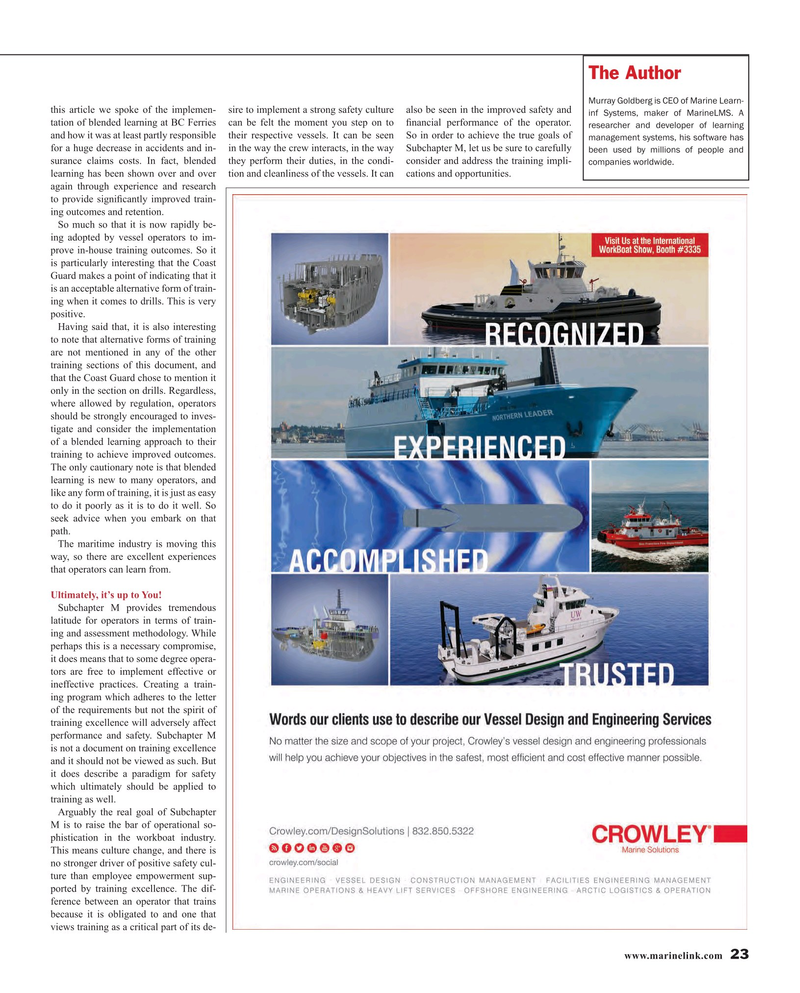
Page 23: of Maritime Reporter Magazine (November 2016)
Workboat Edition
Read this page in Pdf, Flash or Html5 edition of November 2016 Maritime Reporter Magazine
The Author
Murray Goldberg is CEO of Marine Learn- this article we spoke of the implemen- sire to implement a strong safety culture also be seen in the improved safety and inf Systems, maker of MarineLMS. A tation of blended learning at BC Ferries can be felt the moment you step on to ? nancial performance of the operator. researcher and developer of learning and how it was at least partly responsible their respective vessels. It can be seen So in order to achieve the true goals of management systems, his software has for a huge decrease in accidents and in- in the way the crew interacts, in the way Subchapter M, let us be sure to carefully been used by millions of people and surance claims costs. In fact, blended they perform their duties, in the condi- consider and address the training impli- companies worldwide.
learning has been shown over and over tion and cleanliness of the vessels. It can cations and opportunities.
again through experience and research to provide signi? cantly improved train- ing outcomes and retention.
So much so that it is now rapidly be- ing adopted by vessel operators to im- prove in-house training outcomes. So it is particularly interesting that the Coast
Guard makes a point of indicating that it is an acceptable alternative form of train- ing when it comes to drills. This is very positive.
Having said that, it is also interesting to note that alternative forms of training are not mentioned in any of the other training sections of this document, and that the Coast Guard chose to mention it only in the section on drills. Regardless, where allowed by regulation, operators should be strongly encouraged to inves- tigate and consider the implementation of a blended learning approach to their training to achieve improved outcomes.
The only cautionary note is that blended learning is new to many operators, and like any form of training, it is just as easy to do it poorly as it is to do it well. So seek advice when you embark on that path.
The maritime industry is moving this way, so there are excellent experiences that operators can learn from.
Ultimately, it’s up to You!
Subchapter M provides tremendous latitude for operators in terms of train- ing and assessment methodology. While perhaps this is a necessary compromise, it does means that to some degree opera- tors are free to implement effective or ineffective practices. Creating a train- ing program which adheres to the letter of the requirements but not the spirit of training excellence will adversely affect performance and safety. Subchapter M is not a document on training excellence and it should not be viewed as such. But it does describe a paradigm for safety which ultimately should be applied to training as well.
Arguably the real goal of Subchapter
M is to raise the bar of operational so- phistication in the workboat industry.
This means culture change, and there is no stronger driver of positive safety cul- ture than employee empowerment sup- ported by training excellence. The dif- ference between an operator that trains because it is obligated to and one that views training as a critical part of its de- www.marinelink.com 23
MR #11 (18-25).indd 23 11/4/2016 2:31:23 PM

 22
22

 24
24
